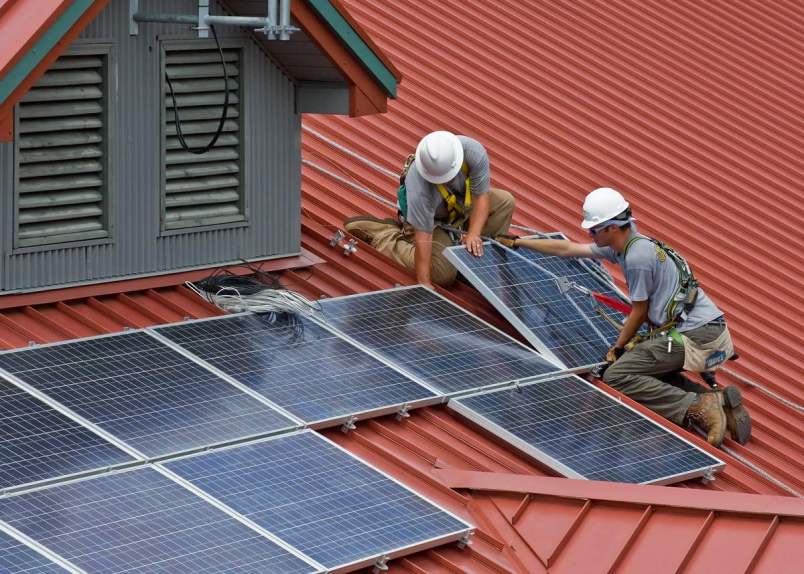The U.S. solar market is thriving among fierce global competition — even besting China last year when it came to trade between the two countries, according to a new report from GTM Research and the Solar Energy Industries Association.
The industry hit a record $1.9 billion in net total exports in 2010, according to the new report from GTM Research and SEIA. That’s up from $723 million in 2009.
The latest figure came from calculating the difference between $5.6 billion in total exports and $3.7 billion in imports in 2010.
The other good news: the U.S. solar industry managed to achieve a positive trade balance with China, posting net exports between $247 million and $540 million (true value unknown due to corporate confidentiality), according to the report.
Meanwhile, the U.S. economy ran an annual global trade deficit of $497.8 billion last year, with exports up to $1.8 trillion but imports up even more, to $2.3 trillion.
The news is even more remarkable considering the fact that Chinese solar panel manufacturers represent 58 percent of the world market, according to the New York Times.
Besides China, the biggest export markets for American solar products were Germany and Japan.
American solar installations also pulled in $4.4 billion in direct value for the U.S. economy, about $0.75 for every dollar spent on a U.S. solar institution, according to the report.
Overall, U.S. solar companies earned $4.4 billion in domestic revenue, the amount made after subtracting their production costs, some of which went to other countries. For every dollar spent by U.S. solar companies to make their products, $0.75 came back to the U.S.
The main export product from the U.S. was polysilicon – a raw material made-up of several different silicon crystals that are used as the base material in photovoltaic solar panels, the most common type found of solar installation, found throughout the world and in orbit on satellites. Total polysilicon exports accounted for $2.5 billion in 2010, with three American facilities leading the country in production: REC’s two plants in Washington state and Hemlock’s plant in Michigan.
The report actually notes a decrease in U.S. market share in polysilicon production from last year, “due to the proliferation of a number of Asian polysicilion manufacturers.”
China actually beat America in polysilicon production, taking 33 percent of the global market compared to America’s 25 percent. Still, Chinese demand exceeded their own ability to supply polysilicon, leading them to import a good chunk from the U.S.
By contrast, the U.S. imported from China somewhere between $1.7 and $2 billion worth of photovoltaic modules (arrangements of photovoltaic solar cells) last year.
In fact, if there’s one thing that comes out abundantly clear in the report, other than that America is no slouch when it comes to solar energy technology production and trade, it’s that the solar industry is truly a global phenomena, with companies on different continents owning different aspects of solar array production.
For example, European companies lead the way in sales of inverters (the device responsible for converting photovoltaic DC current to usable AC power), a $6.7 billion maket.
China, Taiwan and Japan utterly dominated production of polysilicon wafers (polysilicon melted into ingots and sliced thin), with a combined 77 percent of the market.
The U.S. was the champion in terms of module assembly – stringing together the solar cells into one array, with 31 percent of the global market compared to China’s 28 percent. But the report makes clear to point out that the majority of value of these components (80 percent) is created outside the U.S.
America also lead the way in domestic production of “thin film,” flexible, ultra-slim solar panels that can be installed in areas where traditional fixed arrays cannot, with one firm, First Solar, manufacturing 87 percent of all those installed at home.
Another area where the U.S. dominated in terms of creating value at home was in mounting structures for photovoltaic modules, which are “typically a pre-engineered system of alumninum or steel racks.” The report found the U.S. produced a whopping 94 percent of its own mounting structures, with the majority of the other 6 percent coming from Mexico.
And the report notes that fully 50 percent of the total U.S. solar revenue last year came from “soft costs,” which include “system design and engineering, legal fees, permitting fees, financing preparation, etc., all of which is typically performed by U.S. companies or U.S. subsidiaries of foreign companies. ”
One thing left out: The amount of taxpayer-funded subsidies the U.S. solar industry received. It amounted to some $1.1 billion in fiscal 2010 – most of it in tax write-offs – according to the Energy Information Administration. That puts solar in third place among renewable subsidies, after biofuels ($6.6 billion) and wind ($5 billion). But it is only a fraction of the total of nearly $37 billion in subsidies paid out to energy companies by the government.
This piece has been revised since its original publication to clarify annual U.S. trade deficit figures. It originally cited the monthly trade deficit.









